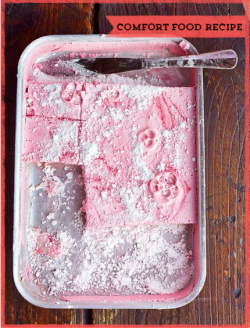Magnificent marshmallows
May 2024
Ingredients
- 50 g cornflour (1/3 cup equals 40g)
- 50 g icing sugar (2/5 cup)
- 50 g liquid glucose syrup, (2.41 tbsp )
- 450 g caster sugar (440g = 2cups)
- 10 sheets of gelatine (1 teaspoon of gelatine equal 2 leaves of gelatine)
- 2 large free-range egg whites
- 2 vanilla pods
- 1½ teaspoons natural food colouring, optional
Choose Your Flavour:
- rose water
- orange blossom water
- natural lemon extract
- natural orange extract
- natural peppermint extract
NOTE
I added 1/4 cup of raspberries zest of 1/2 lemon and 1/2 an orange to flavour to flavour half quantity of this recipe and some rose colouring

Method
Making and serving marshmallows is just one of those magnificently therapeutic, fun things to do. It's kind of weird, but feels like magic – and as much as I love a homemade marshmallow (which does taste better than a bought one), it's the outrageous pleasure that they give my kids when they taste that freshly made gooey delicious treat that's important for me. And they make really good presents and gifts. You can cut and shape them however you please, and flavour them in really fun ways, toast them over fires, melt them over cheesecake, have them sandwiched between chocolate-drizzled cookies or even melted over ice cream. Heaven!
This is a precise recipe, so make sure you read through the method carefully before you start, get all your ingredients weighed out and get your equipment ready to go. You'll be working with hot sugar and syrups, so it's best to keep your kids out of the kitchen until those marshmallows are cooling, ready to eat.
Sift the cornflour and icing sugar into a bowl. Finely sift half the mixture over a deep baking tray (20cm x 30cm) and set the other half aside in the sieve until later. Mix the liquid glucose syrup and caster sugar together in a pan over a low heat with 250ml of cold water. Heat gently, stirring until all the sugar has dissolved and you have a clear syrup. Meanwhile, soak the gelatine leaves in a small pan with 125ml of water.
Once the sugar syrup is clear, turn up the heat, pop in a sugar thermometer and allow the syrup to boil vigorously (please don't stir it). When it reaches 110°C, place the gelatine pan over a medium heat and stir until dissolved. Whisk the egg whites in a free-standing electric mixer until you have stiff peaks. Once your syrup has reached 122°C, very carefully and slowly pour it down the sides of the bowl of the moving mixer, then pour in the dissolved gelatine. Halve the vanilla pods lengthways and scrape out the seeds, add the seeds to the mixer bowl, then continue to whisk for 6 to 8 minutes, or until the mixture has significantly increased in volume, but is thick and still pourable. You can have a plain white vanilla marshmallow, or you can add any of the flavours listed, to taste (remembering to start small as you can always add more, but you can't take it away!). Add any natural food colouring at the same time (if using) – I like to try to match the colour of the marshmallow to the flavour I'm using – whisking for a further 2 to 3 minutes to give you a nice even colour and flavour. Either way, pour the marshmallow mixture into your prepared tray, use a palette knife to smooth it out, then sift over the remaining mixed cornflour and icing sugar and leave somewhere cool for 2 to 3 hours, or until set and soft.
| Stage | Fahrenheit (degrees F) | Celsius (degrees C) | Appearance and Uses | |
| Thread | 223-234 degreesF | 106-112degrees C | Syrup will form a loose thin thread. Used for sugar syrups.
|
|
| Soft Ball | 234-240 degrees F | 112-115degrees C | Syrup will form a soft, sticky ball that can be flattened when removed from the water. Used for caramels, fudge, pralines, fondant, and butter creams.
|
|
| Firm Ball | 242-248 degrees F | 116-120degrees C | Syrup will form a firm but pliable, sticky ball that holds it shape briefly. Used for caramels, butter creams, nougat, marshmallows, Italian meringues, gummies, and toffees.
|
|
| Hard Ball | 250-266 degrees F | 122-130degrees C | Syrup will form a hard, sticky ball that holds its shape. Used for caramels, nougat, divinity and toffees.
|
|
| Soft Crack | 270-290 degrees F | 132-143degrees C | Syrup will form strands that are firm yet pliable. Used for butterscotch, firm nougat, and taffy.
|
|
| Hard Crack | 295-310 degrees F | 146-155degrees C | Syrup will form threads that are stiff (brittle) and break easily. Used for brittles, toffees, glazed fruit, hard candy, pulled poured and spun sugar.
|
|
| Caramel | 320-360 degrees F | 160-182degrees C | Syrup will become transparent and will change color, ranging from light golden brown to dark amber. Used for pralines, brittles, caramel-coated molds, and nougatine. | |
Read more:http://www.joyofbaking.com/StagesOfCookedSugar.html#ixzz3MlRhXdhX